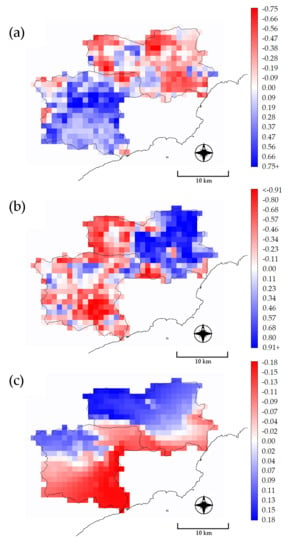Assessing Water Availability in Mediterranean Regions Affected by Water Conflicts through MODIS Data Time Series Analysis
Abstract
1. Introduction
- Time series of MODIS data (i.e., NDVI and LST) were compiled and used to compute their time series anomalies for temporal change detection. Current precipitation and reservoir storage time series anomalies were also computed.
- The correlation among time series anomalies was statistically assessed. Additionally, correlation images between reservoir storage and the spatial variables (NDVI, LST and current precipitation) were computed. The use of a land cover map, along with bibliographic references and the knowledge of the study area allowed the identification of areas and land uses that may influence the availability of water resources.
- Finally, spatial regression analysis was used to evaluate the potential of NDVI and LST time series as predictors of future precipitation changes by taking into account the spatial autocorrelation of the variables.
2. Materials and Methods
2.1. Remote-Sensing Images and Ancillary Geospatial Information
2.2. Climate and Reservoirs Storage Data
2.3. Statistical Methods
3. Results
3.1. Correlation between NDVI, LST and Precipitation
3.2. Time Series Anomalies Patterns
3.3. Spatial-Temporal Relationships between Reservoir Storage, Vegetation Greenness, LST and Precipitation
4. Discussion
4.1. Impacts of Predicted Precipitation Scenarios
4.2. Correlation between Time Series Anomalies of NDVI, LST, Precipitation and Water Reservoir Changes
4.3. Assessing Water Demands and Usage with MODIS Derived Products
5. Conclusions
Author Contributions
Funding
Acknowledgments
Conflicts of Interest
References
- Vicente-Serrano, S.M. Evaluating the Impact of Drought Using Remote Sensing in a Mediterranean, Semi-arid Region. Nat. Hazards 2007, 40, 173–208. [Google Scholar] [CrossRef]
- Giorgi, F.; Lionello, P. Climate change projections for the Mediterranean region. Glob. Planet. Chang. 2008, 63, 90–104. [Google Scholar] [CrossRef]
- Vera-Rebollo, J.F. Cambio climático y política turística en España: Diagnóstico del litoral mediterráneo español. Cuadernos de Turismo 2016, 38, 323–359. [Google Scholar] [CrossRef]
- Verheye, W.H. Dry Lands and Desertification. In Encyclopedia of Land Use, Land Cover Soil Sciences; Verheye, W.H., Ed.; United Nations Educational, Scientific and Cultural Organization (UNESCO) and Encyclopedia of Life Support Systems (EOLSS): Paris, France, 2009; pp. 1–40. [Google Scholar]
- Olcina Cantos, J. Cambio climático y riesgos climáticos en España. Investigaciones Geográficas 2009, 197–220. [Google Scholar] [CrossRef]
- Ostendorf, B. Overview: Spatial information and indicators for sustainable management of natural resources. Ecol. Indic. 2011, 11, 97–102. [Google Scholar] [CrossRef]
- De Araujo Barbosa, C.C.; Atkinson, P.M.; Dearing, J.A. Remote sensing of ecosystem services: A systematic review. Ecol. Indic. 2015, 52, 430–443. [Google Scholar] [CrossRef]
- IPCC. Part A: Global and Sectoral Aspects. Contribution of Working Group II to the Fifth Assessment Report of the Intergovernmental Panel on Climate Change. In Climate Change 2014: Impacts, Adaptation, Vulnerability; Field, C.B., Barros, V.R., Dokken, D.J., Mach, K.J., Mastrandrea, M.D., Bilir, T.E., Chatterjee, M., Ebi, K.L., Estrada, Y.O., Genova, R.C., et al., Eds.; Cambridge University Press: Cambridge, UK; New York, NY, USA, 2014; ISBN 978-1-107-64165-5. [Google Scholar]
- World Water Assessment Programme. The United Nations World Water Development. Report 3: Water in a Changing World; United Nations Educational, Scientific and Cultural Organization (UNESCO)/Earthscan: Paris, France; London, UK, 2009; p. 429. ISBN 978-9-23104-095-5. [Google Scholar]
- Consorcio de Aguas de la Marina Baja. Available online: https://www.diarioinformacion.com/especiales/dia-mundial-agua/2018/03/consorcio-aguas-marina-baja-mejor-gestion-integral-recursos-n1433_1_42849.html (accessed on 4 June 2019).
- Lehner, B.; Liermann, C.R.; Revenga, C.; Vörömsmarty, C.; Fekete, B.; Crouzet, P.; Döll, P.; Endejan, M.; Frenken, K.; Magome, J.; et al. High-resolution mapping of the world’s reservoirs and dams for sustainable river-flow management. Front. Ecol. Environ. 2011, 9, 494–502. [Google Scholar] [CrossRef]
- IPCC-TGICA. General Guidelines on the Use of Scenario Data for Climate Impact Adaptation Assessment, 2nd ed.; Intergovernmental Panel on Climate Change (IPCC)-Task Group on Data and Scenario Support for Impact and Climate Assessment (TGICA): Geneva, Switzerland, 2007; p. 66. [Google Scholar]
- García-Ruiz, J.M.; López-Moreno, J.I.; Vicente-Serrano, S.M.; Lasanta, T.; Beguería, S. Mediterranean water resources in a global change scenario. Earth-Sci. Rev. 2011, 105, 121–139. [Google Scholar] [CrossRef]
- Mereu, S.; Sušnik, J.; Trabucco, A.; Daccache, A.; Vamvakeridou-Lyroudia, L.; Renoldi, S.; Virdis, A.; Savić, D.; Assimacopoulos, D. Operational resilience of reservoirs to climate change, agricultural demand, and tourism: A case study from Sardinia. Sci. Total Environ. 2016, 543, 1028–1038. [Google Scholar] [CrossRef] [PubMed]
- Mühlbauer, S.; Costa, A.C.; Caetano, M. A spatiotemporal analysis of droughts and the influence of North Atlantic Oscillation in the Iberian Peninsula based on MODIS imagery. Theor. Appl. Climatol. 2016, 124, 703–721. [Google Scholar] [CrossRef]
- Nilsson, C. Reservoirs. Encycl. Inland Waters 2009, 625–633. [Google Scholar] [CrossRef]
- Nemani, R.; Running, S. Land Cover characterization using multitemporal RED, NEAR-IR, and THERMAL-IR data from NOAA/AVHRR. Ecol. Appl. 1997, 7, 79–90. [Google Scholar] [CrossRef]
- Zhan, Z.; Qin, Q.; Wang, X. The application of LST/NDVI index for monitoring land surface moisture in semiarid area. In Proceedings of the International Geoscience Remote Sensing Symposium (IGARSS), Anchorage, AK, USA, 27 December 2004; Volume 3, pp. 1551–1554. [Google Scholar]
- Leroux, L.; Baron, C.; Zoungrana, B.; Traore, S.B.; Lo Seen, D.; Begue, A. Crop Monitoring Using Vegetation and Thermal Indices for Yield Estimates: Case Study of a Rainfed Cereal in Semi-Arid West Africa. IEEE J. Sel. Top. Appl. Earth Obs. Remote Sens. 2016, 9, 347–362. [Google Scholar] [CrossRef]
- Colliander, A.; Fisher, J.B.; Halverson, G.; Merlin, O.; Misra, S.; Bindlish, R.; Jackson, T.J.; Yueh, S. Spatial Downscaling of SMAP Soil Moisture Using MODIS Land Surface Temperature and NDVI during SMAPVEX15. IEEE Geosci. Remote Sens. Lett. 2017, 14, 2107–2111. [Google Scholar] [CrossRef]
- Tran, H.T.; Campbell, J.B.; Tran, T.D.; Tran, H.T. Monitoring drought vulnerability using multispectral indices observed from sequential remote sensing (Case Study: Tuy Phong, Binh Thuan, Vietnam). GIScience Remote Sens. 2017, 54, 167–184. [Google Scholar] [CrossRef]
- Wang, P.; Li, X.; Gong, J.; Song, C. Vegetation temperature condition index and its application for drought monitoring. In Proceedings of the International Geoscience Remote Sensing Symposium (IGARSS), Sydney, Australia, 9–13 July 2001; Volume 1, pp. 141–143. [Google Scholar]
- Wan, Z.; Wang, P.; Li, X. Using MODIS Land Surface Temperature and Normalized Difference Vegetation Index products for monitoring drought in the southern Great Plains, USA. Int. J. Remote Sens. 2004, 25, 61–72. [Google Scholar] [CrossRef]
- Cunha, A.P.M.; Alvalá, R.C.; Nobre, C.A.; Carvalho, M.A. Monitoring vegetative drought dynamics in the Brazilian semiarid region. Agric. For. Meteorol. 2015, 214, 494–505. [Google Scholar] [CrossRef]
- Sánchez, N.; González-Zamora, A.; Piles, M.; Martínez-Fernández, J. A new Soil Moisture Agricultural Drought Index (SMADI) integrating MODIS and SMOS products: A case of study over the Iberian Peninsula. Remote Sens. 2016, 8, 287. [Google Scholar] [CrossRef]
- Patel, N.R. Investigating relations between satellite derived land surface parameters and meteorological variables. Geocarto Int. 2006, 21, 47–53. [Google Scholar] [CrossRef]
- Karnieli, A.; Agam, N.; Pinker, R.T.; Anderson, M.; Imhoff, M.L.; Gutman, G.G.; Panov, N.; Goldberg, A. Use of NDVI and land surface temperature for drought assessment: Merits and limitations. J. Clim. 2010, 23, 618–633. [Google Scholar] [CrossRef]
- You, N.; Meng, J.; Zhu, L. Sensitivity and resilience of ecosystems to climate variability in the semi-arid to hyper-arid areas of Northern China: A case study in the Heihe River Basin. Ecol. Res. 2018, 33, 161–174. [Google Scholar] [CrossRef]
- IGME-SGE. Geología de España; Vera, J.A., Ed.; Geological Survey of Spain (IGME) and Spanish Geological Society (SGE): Madrid, Spain, 2004; p. 884. ISBN 84-7840-546-1.
- Generalitat Valenciana. Informe del Sector Agrario Valenciano 2016. Available online: http://www.agroambient.gva.es/es/informes-del-sector-agrario-valenciano (accessed on 12 June 2018).
- IUSS Working Group WRB. World Reference Base for Soil Resources 2014. Update 2015. World Soil Resources Report No. 106; Food and Agriculture Organization of the United Nations (FAO): Rome, Italy, 2015; p. 203. ISBN 978-92-5-108369-7. [Google Scholar]
- European Commission. Soil Atlas of Europe. European Soil Bureau Network European Commission; Office for Official Publications of the European Communities: Luxembourg, 2005; p. 128. ISBN 92-894-8120-X. [Google Scholar]
- AEMET-IMP. Iberian Climate Atlas. Air Temperature Precipitation (1971–2000); Spanish Meteorological Agency (AEMET) and Portuguese Institute of Meteorology (IMP): Madrid, Spain; Lisbon, Portugal, 2011; p. 80. ISBN 978-84-7837-079-5.
- Zaragozí, B.; Navarro, J.T.; Ramón, A.; Rodríguez-Sala, J.J. A Study of Drivers for Agricultural Land Abandonment Using GIS and Data Mining Techniques. In Proceedings of the Eighth International Conference on Ecosystems and Sustainable Development, Alicant, Spain, 13–15 April 2011; Volume 144, pp. 363–374. [Google Scholar]
- Martí, T.T. Use competition and water exchange in Marina Baja district, Alicante, Spain. Water Sci. Technol. Water Supply 2005, 5, 265–272. [Google Scholar] [CrossRef]
- Rico-Amoros, A.M.; Sauri, D.; Olcina-Cantos, J.; Vera-Rebollo, J.F. Beyond Megaprojects? Water Alternatives for Mass Tourism in Coastal Mediterranean Spain. Water Resour. Manag. 2013, 27, 553–565. [Google Scholar] [CrossRef]
- Castaño, S.; Murillo, J.M.; Hernández, L.R. Alternatives in water resources management in Marina Baja district (Alicante province, Spain). In Proceedings of the 3rd International Conference on Future Groundwater Resources at Risk-FGR’01; Ribeiro, L., Ed.; CVRM-Instituto Superior Técnico: Lisbon, Portugal, 2001; pp. 479–486. [Google Scholar]
- Rouse, J.W.; Hass, R.H.; Schell, J.A.; Deering, D.W. Monitoring Vegetation Systems in the Great Plains with ERTS. In Proceedings of the Third Earth Resources Technology Satellite-1 Symposium, Washington, DC, USA, 1 January 1974; pp. 3010–3017. [Google Scholar]
- Huete, A.; Justice, C.; Van Leeuwen, W. MODIS Vegetation Index (MOD 13). Algorithm Theoretical Basis Document. Version 3; NASA Goddard Space Flight Center: Greenbelt, MD, USA, 1999; p. 129.
- Pastor, F.; Gómez, I.; Estrela, M.J. Numerical study of the October 2007 flash flood in the Valencia region (Eastern Spain): The role of orography. Nat. Hazards Earth Syst. Sci. 2010, 10, 1331–1345. [Google Scholar] [CrossRef]
- Akaike, H. A New Look at the Statistical Model Identification. IEEE Trans. Automat. Contr. 1974, 19, 716–723. [Google Scholar] [CrossRef]
- O’brien, R.M. A Caution Regarding Rules of Thumb for Variance Inflation Factors. Qual. Quant. 2007, 41, 673–690. [Google Scholar] [CrossRef]
- R Core Team. R: A Language and Environment for Statistical Computing; R Foundation for Statistical Computing: Vienna, Austria, 2018. [Google Scholar]
- Hijmans, R.J.; Cameron, S.E.; Parra, J.L.; Jones, P.G.; Jarvis, A. Very high resolution interpolated climate surfaces for global land areas. Int. J. Climatol. 2005, 25, 1965–1978. [Google Scholar] [CrossRef]
- Schmidt, G.A.; Ruedy, R.; Hansen, J.E.; Aleinov, I.; Bell, N.; Bauer, M.; Bauer, S.; Cairns, B.; Canuto, V.; Cheng, Y.; et al. Present-Day Atmospheric Simulations Using GISS ModelE: Comparison to In Situ, Satellite, and Reanalysis Data. J. Clim. 2006, 19, 153–192. [Google Scholar] [CrossRef]
- Schmidt, G.A.; Kelley, M.; Nazarenko, L.; Ruedy, R.; Russell, G.L.; Aleinov, I.; Bauer, M.; Bauer, S.E.; Bhat, M.K.; Bleck, R.; et al. Configuration and assessment of the GISS ModelE2 contributions to the CMIP5 archive. J. Adv. Model. Earth Syst. 2014, 6, 141–184. [Google Scholar] [CrossRef]
- Melendez-Pastor, I.; Navarro-Pedreño, J.; Koch, M.; Gómez, I.; Hernández, E.I. Land-Cover Phenologies and Their Relation to Climatic Variables in an Anthropogenically Impacted Mediterranean Coastal Area. Remote Sens. 2010, 2, 697–716. [Google Scholar] [CrossRef]
- Melendez-Pastor, I.; Hernández, E.I.; Navarro-Pedreño, J.; Gómez, I.; Almendro-Candel, M.B. Influence of precipitation and land cover changes in a Mediterranean mountain watershed (Guadalaviar River, Spain). Eur. Water 2017, 57, 141–146. [Google Scholar]
- Barbosa, H.A.; Huete, A.R.; Baethgen, W.E. A 20-year study of NDVI variability over the Northeast Region of Brazil. J. Arid Environ. 2006, 67, 288–307. [Google Scholar] [CrossRef]
- Anselin, L.; McCann, M. OpenGeoDa, open source software for the exploration and visualization of geospatial data. In Proceedings of the ACM International Symposium on Advances in Geographic Information Systems, Tempe, AZ, USA, 4–9 November 2009; pp. 550–551. [Google Scholar]
- Anselin, L.; Syabri, I.; Kho, Y. GeoDa: An Introduction to Spatial Data Analysis. Geogr. Anal. 2006, 38, 5–22. [Google Scholar] [CrossRef]
- Erol, A.; Randhir, T.O. Watershed ecosystem modeling of land-use impacts on water quality. Ecol. Modell. 2013, 270, 54–63. [Google Scholar] [CrossRef]
- Palazón, L.; Navas, A. Modeling sediment sources and yields in a Pyrenean catchment draining to a large reservoir (Ésera River, Ebro Basin). J. Soils Sediments 2014, 14, 1612–1625. [Google Scholar] [CrossRef]
- Julien, Y.; Sobrino, J.A. The Yearly Land Cover Dynamics (YLCD) method: An analysis of global vegetation from NDVI and LST parameters. Remote Sens. Environ. 2009, 113, 329–334. [Google Scholar] [CrossRef]
- Khan, J.; Wang, P.; Xie, Y.; Wang, L.; Li, L. Mapping MODIS LST NDVI Imagery for Drought Monitoring in Punjab Pakistan. IEEE Access 2018, 6, 19898–19911. [Google Scholar] [CrossRef]
- Legendre, P. Spatial Autocorrelation: Trouble or New Paradigm? Ecology 1993, 74, 1659–1673. [Google Scholar] [CrossRef]
- Dutilleul, P. Spatial Heterogeneity and the Design of Ecological Field Experiments. Ecology 1993, 74, 1646–1658. [Google Scholar] [CrossRef]
- Anderson, L.O.; Malhi, Y.; Aragão, L.E.O.C.; Saatchi, S. Spatial patterns of the canopy stress during 2005 drought in Amazonia. In Proceedings of the 2007 IEEE International Geoscience and Remote Sensing Symposium, Barcelona, Spain, 23–28 July 2007; pp. 2294–2297. [Google Scholar]
- González-Loyarte, M.M.; Menenti, M. Impact of rainfall anomalies on Fourier parameters of NDVI time series of northwestern Argentina. Int. J. Remote Sens. 2008, 29, 1125–1152. [Google Scholar] [CrossRef]
- Vicente-serrano, S.M.; Gouveia, C.; Julio, J.; Beguería, S.; Trigo, R. Response of vegetation to drought time-scales across global land biomes. Proc. Natl. Acad. Sci. USA 2012, 110, 52–57. [Google Scholar] [CrossRef] [PubMed]
- Belda, F. Relationships between climatic parameters and forest vegetation: Application to burned area in Alicante (Spain). For. Ecol. Manag. 2000, 135, 195–204. [Google Scholar] [CrossRef]
- Melendez-Pastor, I.; Navarro-Pedreño, J.; Gómez, I.; Koch, M. Detecting drought induced environmental changes in a Mediterranean wetland by remote sensing. Appl. Geogr. 2010, 30, 254–262. [Google Scholar] [CrossRef]
- Roerink, G.J.; Menenti, M.; Soepboer, W.; Su, Z. Assessment of climate impact on vegetation dynamics by using remote sensing. Phys. Chem. Earth 2003, 28, 103–109. [Google Scholar] [CrossRef]
- Baltagi, B.H.; Heun Song, S.; Cheol Jung, B.; Koh, W. Testing for serial correlation, spatial autocorrelation and random effects using panel data. J. Econom. 2007, 140, 5–51. [Google Scholar] [CrossRef]
- Yang, X.; Jin, W. GIS-based spatial regression and prediction of water quality in river networks: A case study in Iowa. J. Environ. Manag. 2010, 91, 1943–1951. [Google Scholar] [CrossRef] [PubMed]
- Yin, C.; Yuan, M.; Lu, Y.; Huang, Y.; Liu, Y. Effects of urban form on the urban heat island effect based on spatial regression model. Sci. Total Environ. 2018, 634, 696–704. [Google Scholar] [CrossRef] [PubMed]
- Melendez-Pastor, I.; Navarro-Pedreño, J.; Koch, M.; Gómez, I. Multi-resolution and temporal characterization of land use classes in a Mediterranean wetland with land cover fractions. Int. J. Remote Sens. 2010, 31, 5365–5389. [Google Scholar] [CrossRef]
- Van Oijen, M.; Balkovi, J.; Beer, C.; Cameron, D.R.; Ciais, P.; Cramer, W.; Kato, T.; Kuhnert, M.; Martin, R.; Myneni, R.; et al. Impact of droughts on the carbon cycle in European vegetation: A probabilistic risk analysis using six vegetation models. Biogeosciences 2014, 11, 6357–6375. [Google Scholar] [CrossRef]
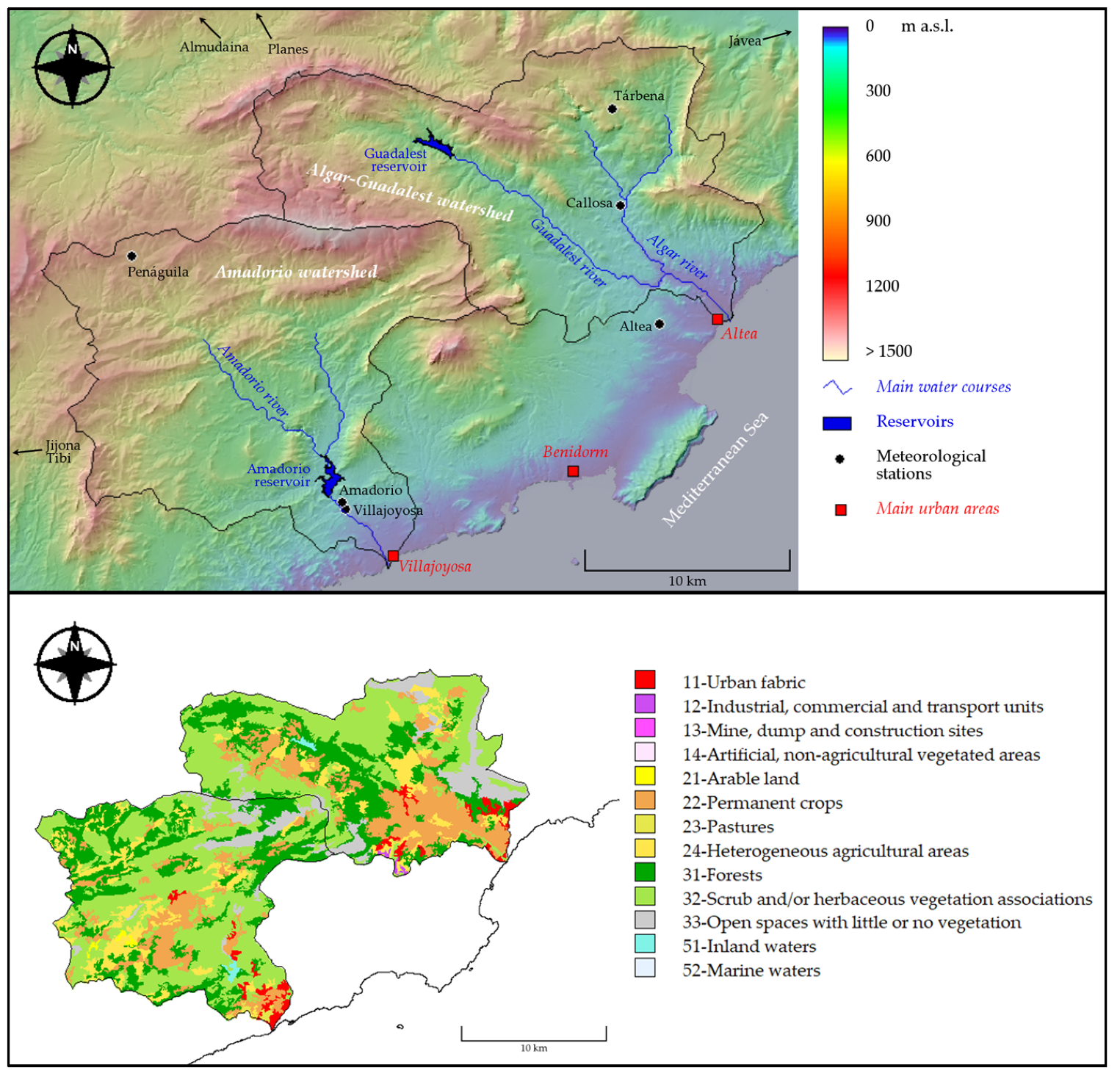
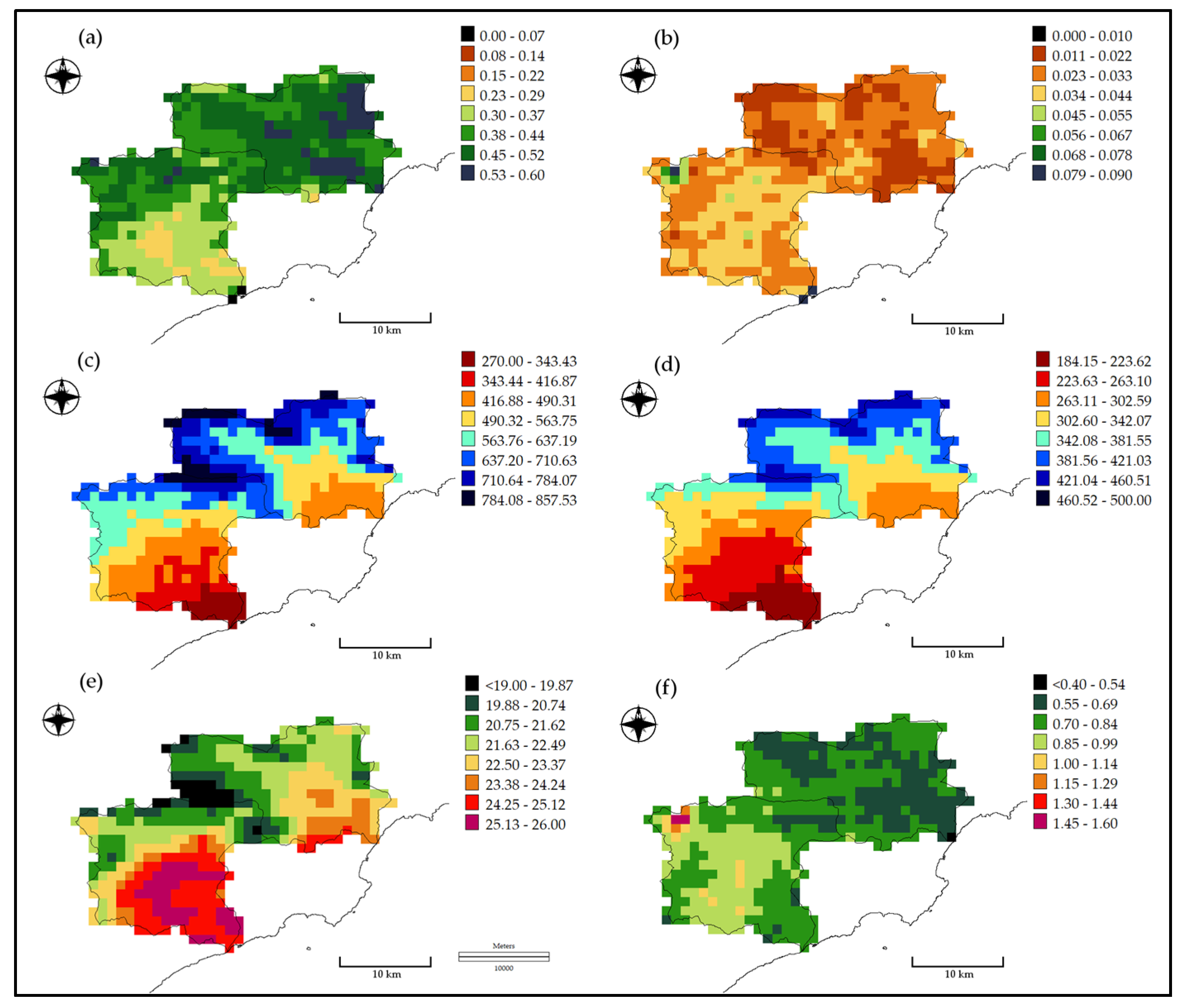
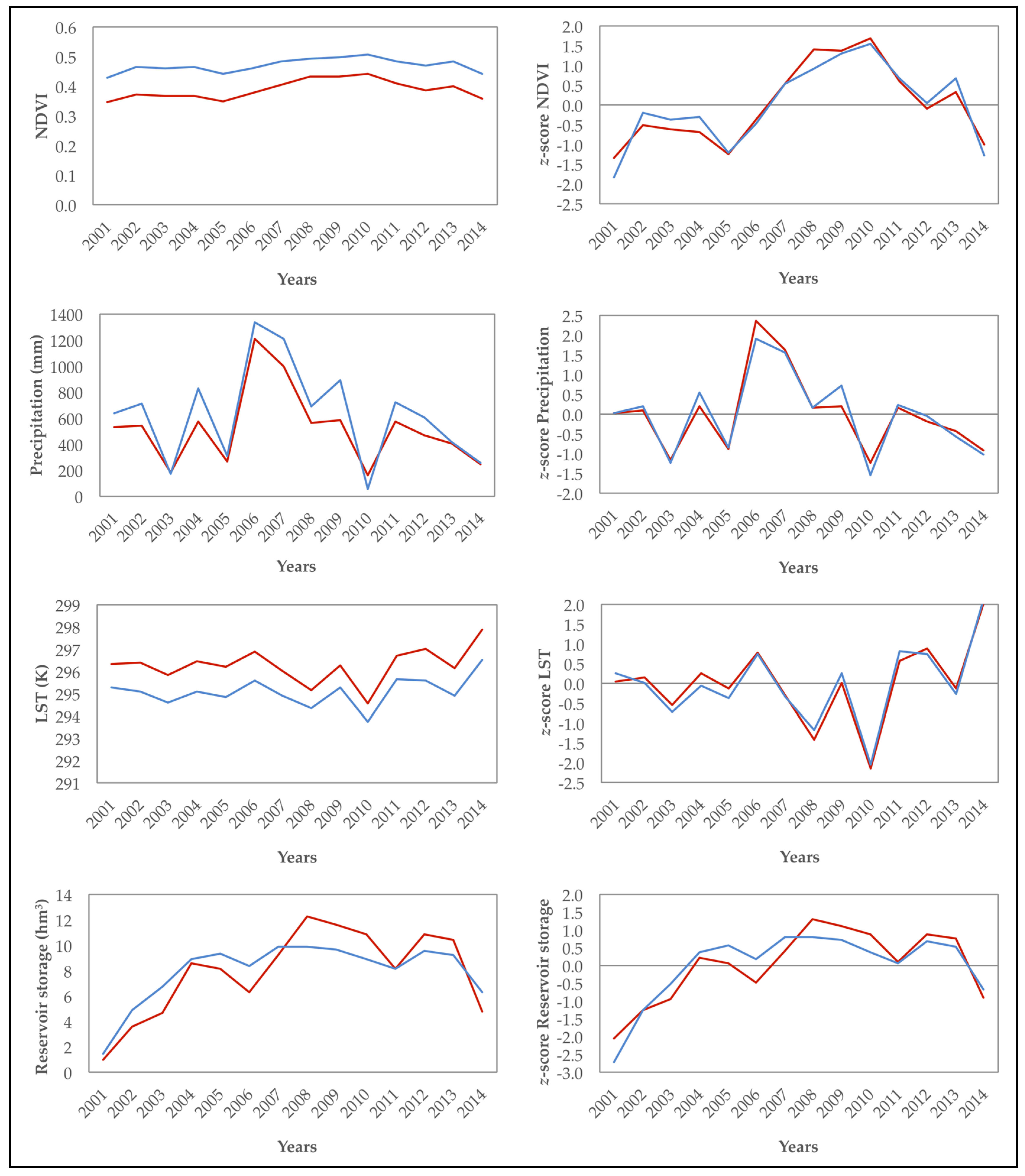
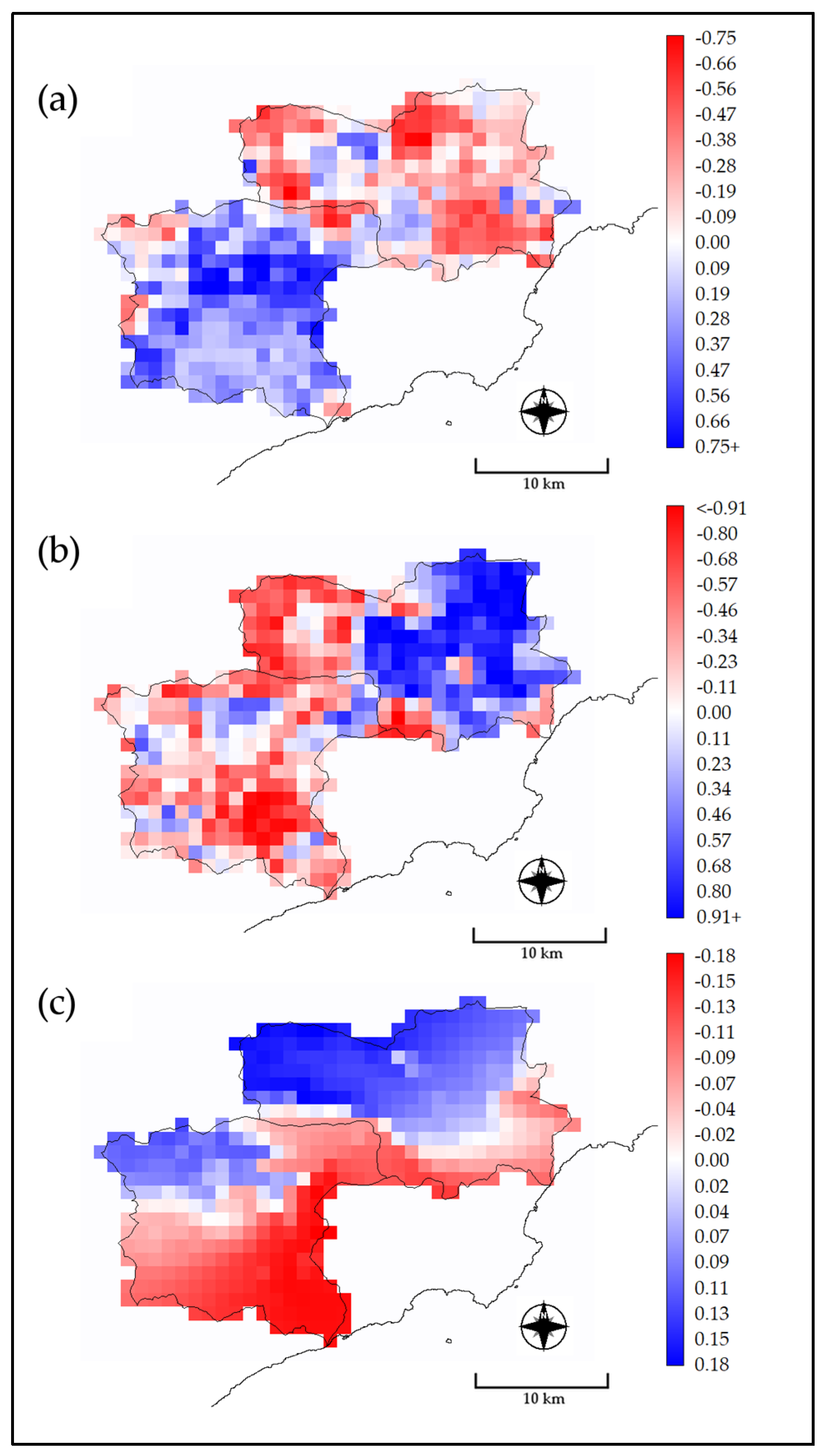
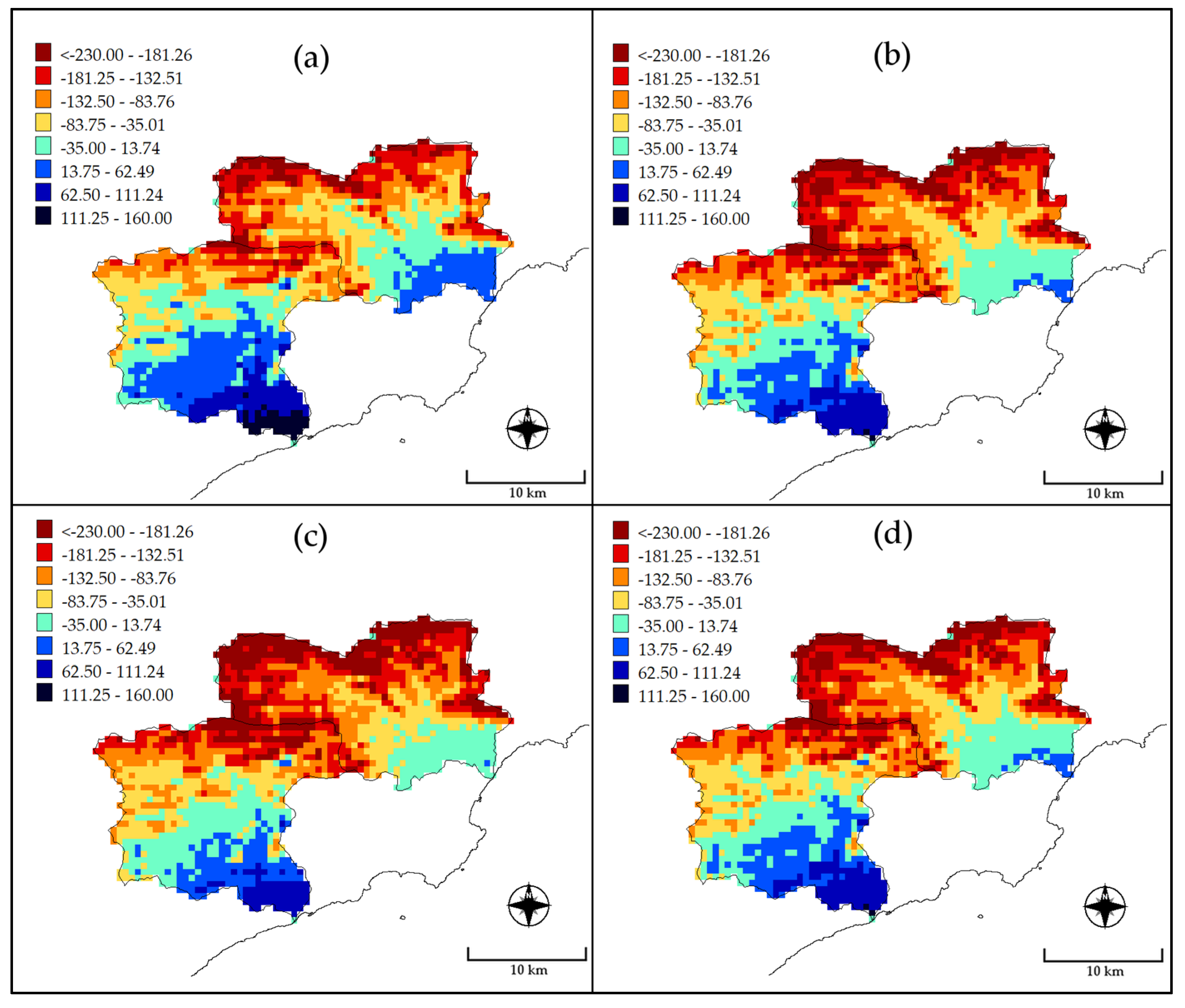
| Variables | NDVI | Precipitation | LST | Reservoir Storage | |||||
|---|---|---|---|---|---|---|---|---|---|
| A-G | Am. | A-G | Am. | A-G | Am. | A-G | Am. | ||
| NDVI | A-G | 1 | 0.956 ** | 0.103 | 0.125 | −0.376 | −0.473 | 0.565 * | 0.824 ** |
| Am. | 0.956 ** | 1 | 0.165 | 0.196 | −0.305 | −0.433 | 0.565 * | 0.802 ** | |
| Precipitation | A-G | 0.103 | 0.165 | 1 | 0.996 ** | 0.349 | 0.288 | 0.262 | 0.090 |
| Am. | 0.125 | 0.196 | 0.996 ** | 1 | 0.323 | 0.257 | 0.310 | 0.143 | |
| LST | A-G | −0.376 | −0.305 | 0.349 | 0.323 | 1 | 0.930 ** | −0.403 | −0.363 |
| Am. | −0.473 | −0.433 | 0.288 | 0.257 | 0.930 ** | 1 | −0.370 | −0.367 | |
| Reservoir storage | A-G | 0.565 * | 0.565 * | 0.262 | 0.310 | −0.403 | −0.370 | 1 | 0.843 ** |
| Am. | 0.824 ** | 0.802 ** | 0.090 | 0.143 | −0.363 | −0.367 | 0.843 ** | 1 | |
| Precipitation Predictions | Adj. R2 | p-Value | Variables | Coefficient | Std. Error | p-Value | |
|---|---|---|---|---|---|---|---|
| Future precipitation predictions | RCP26 | 0.819 | <0.001 | Constant | 1006.885 | 25.508 | <0.001 |
| Elevation | 0.043 | 0.005 | <0.001 | ||||
| LST (mean 2001–2014) | −22.478 | 1.016 | <0.001 | ||||
| RCP45 | 0.829 | <0.001 | Constant | 927.370 | 23.672 | <0.001 | |
| Elevation | 0.049 | 0.005 | <0.001 | ||||
| LST (mean 2001–2014) | −20.206 | 0.942 | <0.001 | ||||
| RCP60 | 0.835 | <0.001 | Constant | 898.844 | 22.895 | <0.001 | |
| Elevation | 0.051 | 0.005 | <0.001 | ||||
| LST (mean 2001–2014) | −19.607 | 0.911 | <0.001 | ||||
| RCP85 | 0.828 | <0.001 | Constant | 937.138 | 23.380 | <0.001 | |
| Elevation | 0.045 | 0.005 | <0.001 | ||||
| LST (mean 2001–2014) | −20.557 | 0.931 | <0.001 | ||||
| Precipitation change (future prediction-present) | RCP26 | 0.722 | <0.001 | Constant | 70.006 | 4.533 | <0.001 |
| Elevation | −0.214 | 0.007 | <0.001 | ||||
| LST correlogram image | −42.773 | 4.093 | <0.001 | ||||
| NDVI correlogram image | 57.910 | 5.863 | <0.001 | ||||
| RCP45 | 0.725 | <0.001 | Constant | 47.297 | 4.610 | <0.001 | |
| Elevation | −0.217 | 0.007 | <0.001 | ||||
| LST correlogram image | −44.878 | 4.162 | <0.001 | ||||
| NDVI correlogram image | 62.657 | 5.961 | <0.001 | ||||
| RCP60 | 0.727 | <0.001 | Constant | 33.717 | 4.637 | <0.001 | |
| Elevation | −0.219 | 0.007 | <0.001 | ||||
| LST correlogram image | −45.595 | 4.187 | <0.001 | ||||
| NDVI correlogram image | 64.455 | 5.997 | <0.001 | ||||
| RCP85 | 0.731 | <0.001 | Constant | 48.234 | 4.587 | <0.001 | |
| Elevation | −0.220 | 0.007 | <0.001 | ||||
| LST correlogram image | −44.471 | 4.142 | <0.001 | ||||
| NDVI correlogram image | 62.243 | 5.932 | <0.001 |
© 2019 by the authors. Licensee MDPI, Basel, Switzerland. This article is an open access article distributed under the terms and conditions of the Creative Commons Attribution (CC BY) license (http://creativecommons.org/licenses/by/4.0/).
Share and Cite
Marco-Dos Santos, G.; Melendez-Pastor, I.; Navarro-Pedreño, J.; Koch, M. Assessing Water Availability in Mediterranean Regions Affected by Water Conflicts through MODIS Data Time Series Analysis. Remote Sens. 2019, 11, 1355. https://doi.org/10.3390/rs11111355
Marco-Dos Santos G, Melendez-Pastor I, Navarro-Pedreño J, Koch M. Assessing Water Availability in Mediterranean Regions Affected by Water Conflicts through MODIS Data Time Series Analysis. Remote Sensing. 2019; 11(11):1355. https://doi.org/10.3390/rs11111355
Chicago/Turabian StyleMarco-Dos Santos, Gema, Ignacio Melendez-Pastor, Jose Navarro-Pedreño, and Magaly Koch. 2019. "Assessing Water Availability in Mediterranean Regions Affected by Water Conflicts through MODIS Data Time Series Analysis" Remote Sensing 11, no. 11: 1355. https://doi.org/10.3390/rs11111355
APA StyleMarco-Dos Santos, G., Melendez-Pastor, I., Navarro-Pedreño, J., & Koch, M. (2019). Assessing Water Availability in Mediterranean Regions Affected by Water Conflicts through MODIS Data Time Series Analysis. Remote Sensing, 11(11), 1355. https://doi.org/10.3390/rs11111355






